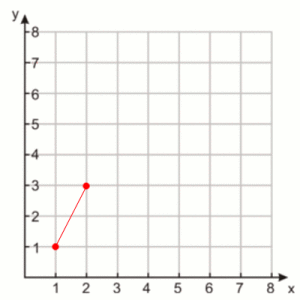Line Equations in Python
The other day I was playing with some Python challenges found on a popular sites, this challenge worked with xy coordinates on a 2D plane.
I wanted to show some of the code I wrote and how they work.
The Plane
Being the data is a tuple of x, y coordinates we will use the Cartesian Coordinate System .
I started my code off as a simple Python class:
class Line(object):
def __init__(self, data):
self.first, self.second = data
Using this Class I can input two points in a tuple like this:
data = ((1,1), (2,3))
These coordinates would look like this on a 2D plane:
The Line
The coordinates ((1,1), (2,3)) holds quite a bit of data when it comes to the terms of Algebra.
Slope
The Slope of a line will tell us how steep it is, and can be calculated with the change in Y / change int X .
def slope(self):
'''Get the slope of a line segment'''
(x1, y1), (x2, y2) = self.first, self.second
try:
return (float(y2)-y1)/(float(x2)-x1)
except ZeroDivisionError:
# line is vertical
return None
Using the slope method tells us this line has a slope of 2 .
>>> data = ((1,1), (2,3))
>>> line = Line(data)
>>> m = line.slope()
>>> print m
2.0
Y Intercept
The Y Intercept tells us at what point a line will meet the Y axis. To get a Y Intercept we use the equation b = y - mx where m is our slope .
def yintercept(self, slope):
'''Get the y intercept of a line segment'''
if slope != None:
x, y = self.first
return y - slope * x
else:
return None
And if we plug all our data back in we get a intercept of -1 :
>>> b = line.yintercept(slope)
>>> print b
-1.0
Solve for Y
Now that we know the slope of our line, and where our line meets the Y Axis we can plug in any X coordinate and solve for where Y will be:
def solve_for_y(self, x, slope, yintercept):
'''Solve for Y cord using line equation'''
if slope != None and yintercept != None:
return float(slope) * x + float(yintercept)
else:
raise Exception('Can not solve on a vertical line')
And just like that we can when X is equal to 3 our Y will be 5 , just look at the graph above and imagaine.
>>> line.solve_for_y(3, m, b)
5.0
Solve for X
And lastly using our slope and Y intercept we can solve for X when Y is some value:
def solve_for_x(self, y, slope, yintercept):
'''Solve for X cord using line equatio'''
if slope != 0 and slope:
return float((y - float(yintercept))) / float(slope)
else:
raise Exception('Can not solve on a horizontal line')
And we can do the reverse of above to verify they are both working, when X is equal to 5 our Y should be 3 :
>>> line.solve_for_x(5, m, b)
3.0
Put it all together
class Line(object):
def __init__(self, data):
self.first, self.second = data
def slope(self):
'''Get the slope of a line segment'''
(x1, y1), (x2, y2) = self.first, self.second
try:
return (float(y2)-y1)/(float(x2)-x1)
except ZeroDivisionError:
# line is vertical
return None
def yintercept(self, slope):
'''Get the y intercept of a line segment'''
if slope != None:
x, y = self.first
return y - slope * x
else:
return None
def solve_for_y(self, x, slope, yintercept):
'''Solve for Y cord using line equation'''
if slope != None and yintercept != None:
return float(slope) * x + float(yintercept)
else:
raise Exception('Can not solve on a vertical line')
def solve_for_x(self, y, slope, yintercept):
'''Solve for X cord using line equatio'''
if slope != 0 and slope:
return float((y - float(yintercept))) / float(slope)
else:
raise Exception('Can not solve on a horizontal line')
